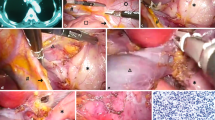Abstract
Background
For thymoma, the feasibility of resection via video-assisted thoracoscopic surgery (VATS) remains controversial. The objective of our study was to compare the outcomes of VATS and transsternal thymectomy in order to evaluate the efficacy of the VATS method for treatment of early stage thymoma.
Methods
This study is a retrospective study of 120 patients who underwent thymectomy of early stage thymoma (Masaoka stage I and II) in a single medical center from 1991 to 2010. Of these patients, 76 patients underwent VATS thymectomy (VATS group) and 44 patients underwent the conventional transsternal approach (sternotomy group). We applied the Kaplan–Meier method to estimate overall survival (OS), recurrence-free survival (RFS), and time to tumor recurrence (TTR) of these two groups.
Results
The mean follow-up time was 61.9 months in the VATS group and 69.7 months in the sternotomy group. There was no surgery-related mortality or major complication. The VATS group had smaller specimen size (p < 0.05) and tumor size (p < 0.01), shorter length of stay (LOS) in the hospital (p < 0.01), and shorter duration of chest tube drainage (p < 0.05) than the sternotomy group. There were no significant differences between the two groups for OS, RFS, and TTR.
Conclusions
In early stage thymoma, VATS thymectomy associated with shorter hospital LOS and shorter duration of pleural drainage compared with the conventional transsternal approach. Otherwise, the two approaches had similar oncologic outcomes during the mean 60-month follow-up period.


Similar content being viewed by others
References
Engels EA, Pfeiffer RM. Malignant thymoma in the United States: demographic patterns in incidence and associations with subsequent malignancies. Int J Cancer. 2003;105:546–51.
Hung YS, Chang CL, Chang H, Lu CH, Chen PT, Chou WC. Thymoma. J Intern Med Taiwan. 2009;20:344–51.
Masaoka A, Monden Y, Nakahara K, Tanioka T. Follow-up study of thymomas with special reference to their clinical stages. Cancer. 1981;48:2485–92.
Kondo K, Monden Y. Therapy for thymic epithelial tumors: a clinical study of 1,320 patients from Japan. Ann Thorac Surg. 2003;76:878–84.
Moore KH, McKenzie PR, Kennedy CW, McCaughan BC. Thymoma: trends over time. Ann Thorac Surg. 2001;72:203–7.
Gawrychowski J, Rokicki M, Gabriel A, Lackowska B, Czyzewski D. Thymoma—the usefulness of some prognostic factors for diagnosis and surgical treatment. Eur J Surg Oncol. 2000;26:203–8.
Suster S, Moran CA. Histologic classification of thymoma: the World Health Organization and beyond. Hematol Oncol Clin North Am. 2008;22:381–92.
Tagawa T, Kometani T, Yamazaki K, et al. Prognosis and therapeutic response according to the World Health Organization histological classification in advanced thymoma. Surg Today. 2011;41:1599–604.
Ruffini E, Filosso PL, Mossetti C, et al. Thymoma: inter-relationships among World Health Organization histology, Masaoka staging and myasthenia gravis and their independent prognostic significance: a single-centre experience. Eur J Cardiothorac Surg. 2011;40:146–53.
Davenport E, Malthaner RA. The role of surgery in the management of thymoma: a systematic review. Ann Thorac Surg. 2008;86:673–84.
Cheng YJ, Kao EL, Chou SH. Videothoracoscopic resection of stage II thymoma: prospective comparison of the results between thoracoscopy and open methods. Chest. 2005;128:3010–2.
Agasthian T, Lin SJ. Clinical outcome of video-assisted thymectomy for myasthenia gravis and thymoma. Asian Cardiovasc Thorac Ann. 2010;18:234–9.
Pennathur A, Qureshi I, Schuchert MJ, et al. Comparison of surgical techniques for early-stage thymoma: feasibility of minimally invasive thymectomy and comparison with open resection. J Thorac Cardiovasc Surg. 2011;141:694–701.
Thomas CR, Wright CD, Loehrer PJ. Thymoma: state of the art. J Clin Oncol. 1999;17:2280–9.
Acknowledgment
This study was supported by the National Taiwan University Hospital (NTUH.102-S2140), the National Health Research Institutes (NHRI-EX102-10032BI), and the National Science Council (NSC101-2314-B002-020-MY3) of the Republic of China.
Disclosure
The authors declare no conflict of interest.
Author information
Authors and Affiliations
Corresponding author
Additional information
Mong-Wei Lin and Min-Shu Hsieh have contributed equally to this article, and both should be considered second authors.
Rights and permissions
About this article
Cite this article
Liu, T.J., Lin, MW., Hsieh, MS. et al. Video-Assisted Thoracoscopic Surgical Thymectomy to Treat Early Thymoma: A Comparison with the Conventional Transsternal Approach. Ann Surg Oncol 21, 322–328 (2014). https://doi.org/10.1245/s10434-013-3228-7
Received:
Published:
Issue Date:
DOI: https://doi.org/10.1245/s10434-013-3228-7




